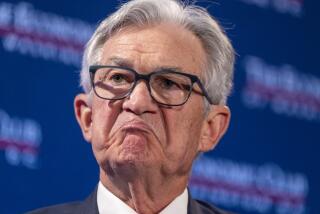REBOUND ON WALL STREET : Discount Broker : Schwab & Co., Stung in 1987, Had Crisis Plan Ready for Fall of 1989
- Share via
Randall N. Kirk, manager of the downtown Los Angeles branch of Charles Schwab & Co., rolled into the office at 4:30 a.m. Monday to prepare for the onslaught.
He was still sleepy. But memories persisted of an October Monday two years ago, when a flood of panicked investors overloaded phone lines at Schwab and other brokerages in the Wall Street selloff that would become Black Monday.
For the record:
12:00 a.m. Oct. 18, 1989 For the Record
Los Angeles Times Wednesday October 18, 1989 Home Edition Business Part D Page 2 Column 3 Financial Desk 1 inches; 32 words Type of Material: Correction
Yvette Boleslav--A caption with a picture that appeared in Tuesday’s editions left the impression that Yvette Boleslav was an employee of Charles Schwab & Co. in Los Angeles. She was actually a customer using an office telephone.
Some investors later charged Schwab with botching, delaying or failing to complete stock transactions; others, mostly individuals, said they simply couldn’t get through.
Stung by the snafus, Schwab made major changes, such as extending hours and adding phone lines, for the next time that trading volumes exploded. That time came Monday, the first market day since an unsettling 190-point drop Friday in the Dow Jones industrial average.
Kirk and other Schwab employees nationwide arrived an hour earlier than usual. By 5 a.m., Kirk’s office was staffed. By 6 a.m., switchboards were turned on, and the flood of calls began.
By the close of trading Monday, the 110 offices of the country’s largest discount brokerage firm had fielded more than 45,000 transactions, overshadowing Friday’s heavy volume of 20,000 transactions and more than four times the normal volume, said Schwab spokesman Mark Thompson in San Francisco.
Unlike 1987, the brokerage took things in stride, investors and Schwab officials said.
Telephone calls to several Southern California Schwab offices were answered by machine but were picked up in less than a minute by a Schwab employee.
“I haven’t had any transactions with them, (but) I did call them a few times (Monday) morning, and I got quick service as far as getting a few quotes,” said investor David Schettini of La Crescenta, who was watching the ticker tape at Schwab’s downtown office.
Schwab was one of several brokerages that anticipated heavy volume and took steps to avoid 1987-style customer complaints. On Monday, Fidelity Investments ran full-page newspaper ads saying “Fidelity is ready for your call.”
After 1987, Schwab doubled its computer links with major exchanges to avoid trading bottlenecks, Thompson said.
More important, Schwab now requires about 90% of its 2,000 branch employees to have broker’s licenses, compared to 60% to 70% in 1987, Thompson said. Now, almost any employee--even those in support functions--can take orders in an emergency.
Schwab also opened a call overflow center, to which calls could be bumped from swamped local offices, and added phone lines for investors using touch-tone phones to obtain quotes or make trades directly.
And the brokerage extended its hours. After Friday’s unexpected drop, Schwab opened all of its branches on Saturday from 9 a.m. to 1 p.m. In addition, employees came to work Sunday to prepare for Monday’s expected deluge. Nationally, Schwab took about 18,000 calls over the weekend, more than three times the normal weekend load on its 24-hour telephone hot lines.
Today, Schwab was scheduled to open an hour earlier, as well. It will decide whether to extend hours through the week depending on market conditions.
Monday, the mood at Schwab’s offices was quite different from that in 1987. “Two years ago at this time, the momentum just kept getting stronger and stronger as the day went on . . . and there was a lot of panic,” a Century City Schwab broker recalled. But this time, “We’re not seeing the panic at this time that we saw two years ago,” the broker said.
In the downtown office, the activity was constant but subdued. No one took much time to lunch on the delivered pizza that grew cold, but Kirk was relaxed enough to chat for a few minutes with a couple of visitors just before the market’s close.
One investor even regretted the relative ease with which he transacted business Friday. It took only about five minutes for a Bellflower resident to reach a broker and sell his shares--at a $3,000 loss.
“They were good, and I wish I hadn’t gotten through now,” he said.
More to Read
Inside the business of entertainment
The Wide Shot brings you news, analysis and insights on everything from streaming wars to production — and what it all means for the future.
You may occasionally receive promotional content from the Los Angeles Times.










